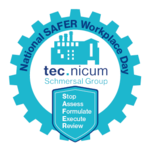You are here
Contact tec.nicum
Use our >Contact form
Or contact:
Devin Murray
Engineering Services Manager
Functional Safety Engineer
(TÜV Rheinland, #4274/11, Machinery)
914-419-3731
dmurray@schmersal.com
Toll free: 888-496-5142
National SAFER Workplace Day
National SAFER Workplace Day is officially registered to occur on the last Friday of June, commemorating the SAFER Workplace initiative.
The next SAFER Workplace Day will take place
Friday June 28th, 2024.
Content
SAFER Workplace
Turning workplaces into safer places has been a long time goal for Schmersal and our engineering services group tec.nicum.
Our SAFER Workplace initiative promotes workplace safety, with a heightened focus on machine safety, to reduce the potential of near misses, accidents, and injuries. Behaving safer to achieve a safer workplace is the goal behind the SAFER acronym. Each letter represents a key step when attempting to implement a safety mindset to minimize work related injuries.
-

STOP
A stop in production often has a negative connotation. However, in this context, it is meant to prevent future production stops due to accidents and injuries. It is important to stop and discuss safety concerns to create and foster a work environment where employees feel confident enough to speak up against unsafe conditions. This also helps to avoid potential near misses and accidents.
-
-

ASSESS
Identifying an unsafe condition is the first step. The next step is to assess the safety concerns to decide which steps (if any) need to be taken to minimize exposure to the hazard. One method to estimate the severity of the concern is by calculating a Hazard Rating Number (HRN) which will allow you to quantify a problem and take a closer look at a machine or process to ensure proper regulations and requirements are being followed.
-
-

FORMULATE
Once an assessment is completed and a concern has been reviewed by a qualified team, the next step is to formulate a plan. If actions need to be taken, this is the time to develop safe and feasible possible solutions. Team effort may be required to create a solution that is not only safe, but allows for effective and efficient human-machine interactions.
-
-

EXECUTE
After a plan is created, it is time to execute it to see how effective it is. This may require planning across multiple departments and divisions as a realistic schedule must be made to accommodate machine downtime and available resources to actually implement the proposed safety plan. It’s important to establish design reviews and milestones to help track and measure the success of process.
-
-

REVIEW
Sometimes the first solution is not always the best, so a redesign may be needed. Once the solution is successfully implemented, the concern must be reviewed again. This additional evaluation is used to confirm that the initial concern has been addressed effectively and that the new solution is not creating further hazards.
-
Following each step allows a systematic approach to effectively identify and correct hazardous machines, tasks, process, and conditions.



